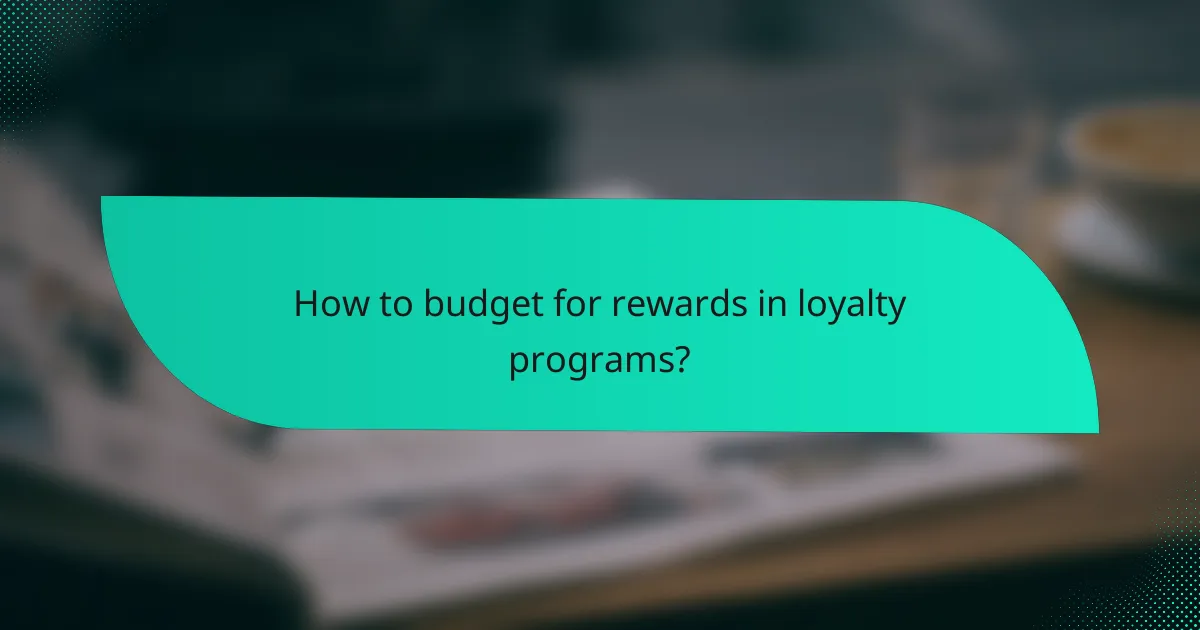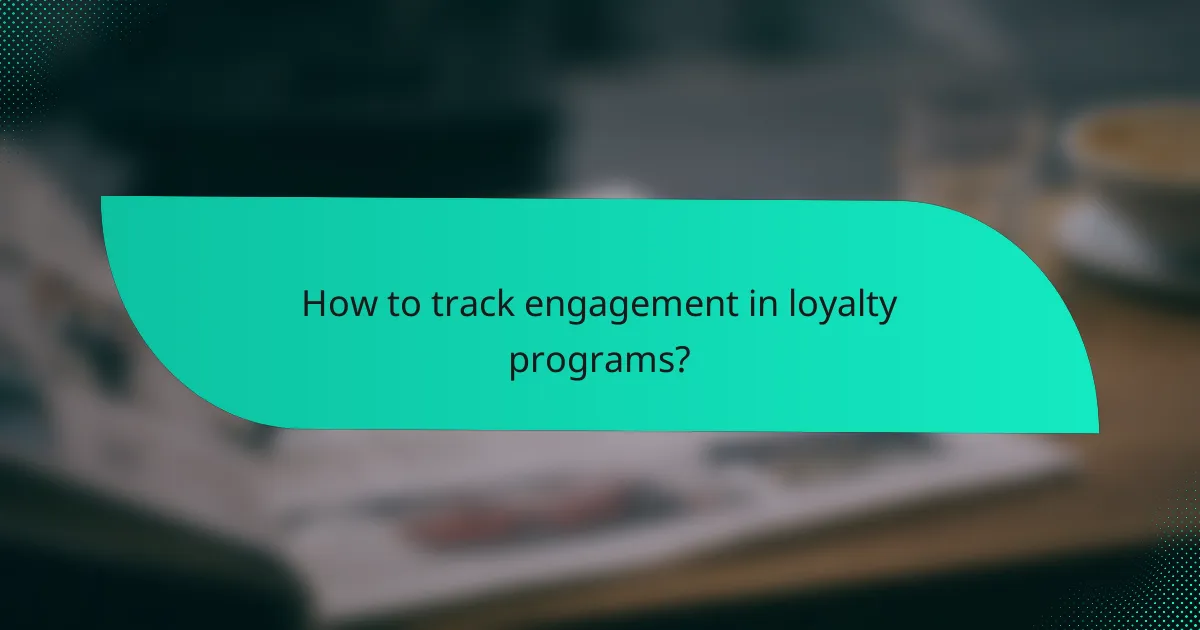Loyalty program campaigns are essential for fostering customer retention and enhancing brand loyalty. Setting up such a program involves various costs, including initial setup, ongoing operations, and technology investments. Additionally, effective budgeting for rewards and diligent tracking of customer engagement are crucial to ensure the program’s sustainability and success.

What are the costs of setting up a loyalty program in the UK?
Setting up a loyalty program in the UK involves several costs that can vary significantly based on the program’s complexity and scale. Key expenses include initial setup costs, ongoing operational expenses, technology investments, marketing efforts, and staff training.
Initial setup costs
Initial setup costs for a loyalty program can range from a few thousand to tens of thousands of pounds, depending on the features you want to implement. Basic programs may require minimal investment, while more sophisticated systems with advanced analytics and customer engagement tools will be pricier.
Consider factors like branding, program design, and customer experience when estimating these costs. Engaging a consultant or agency can also add to the initial expenses.
Ongoing operational expenses
Ongoing operational expenses typically include maintenance costs, customer support, and rewards fulfillment. These costs can amount to a percentage of sales or a fixed monthly fee, depending on the program’s structure.
It’s essential to budget for these expenses to ensure the program remains sustainable over time. Regularly reviewing operational costs can help identify areas for improvement or potential savings.
Technology and software investments
Investing in technology and software is crucial for managing a loyalty program effectively. This may involve purchasing or subscribing to loyalty management software, which can cost anywhere from hundreds to thousands of pounds annually.
When selecting technology solutions, consider integration with existing systems and the scalability of the software to accommodate future growth.
Marketing and promotional costs
Marketing and promotional costs are vital for attracting and retaining customers in a loyalty program. These expenses can include advertising campaigns, promotional materials, and special offers, which may vary widely based on your target audience.
Allocating a dedicated budget for marketing efforts can enhance program visibility and engagement, leading to higher customer participation rates.
Staff training and management
Staff training and management costs are essential for ensuring that employees understand the loyalty program and can effectively communicate its benefits to customers. Training sessions may require investment in materials, time, and possibly external trainers.
Ongoing management of the program also requires staff time, so consider how many employees will be involved and what their roles will be in maintaining the program’s success.

How to budget for rewards in loyalty programs?
Budgeting for rewards in loyalty programs involves determining a percentage of sales to allocate for rewards, selecting appropriate types of rewards, and implementing cost-effective strategies. Proper budgeting ensures that the program remains sustainable while effectively engaging customers.
Percentage of sales for rewards
A common approach to budgeting for rewards is to allocate a percentage of total sales, typically ranging from 1% to 5%. This percentage can vary based on the industry, customer base, and overall marketing strategy. Regularly reviewing sales data can help adjust this percentage to align with business goals.
Consider seasonal fluctuations in sales when determining this percentage. For instance, during peak seasons, you might increase the allocation to enhance customer engagement and drive sales further.
Types of rewards to offer
Rewards can take various forms, including discounts, cashback, free products, or exclusive experiences. Offering a mix of tangible and experiential rewards can cater to different customer preferences and increase program appeal. For example, a retail store might offer a discount on future purchases alongside exclusive access to special events.
It’s important to align rewards with customer interests and behaviors. Conducting surveys or analyzing purchase history can provide insights into what types of rewards will resonate most with your audience.
Cost-effective reward strategies
Implementing cost-effective reward strategies can maximize the impact of your budget. One effective method is to offer tiered rewards, where customers earn greater rewards as they spend more. This not only encourages higher spending but also fosters loyalty.
Another strategy is to partner with other businesses for cross-promotions, allowing you to offer rewards without incurring significant costs. For instance, a coffee shop might collaborate with a local bakery to provide discounts on each other’s products.
Seasonal and promotional budgeting
Seasonal and promotional events present opportunities to adjust your rewards budget. During holidays or special occasions, consider increasing the rewards budget to attract more customers. For example, offering double points during the holiday season can incentivize purchases.
Plan ahead for these events by analyzing past performance and setting aside a specific portion of your budget for seasonal promotions. This proactive approach ensures you can effectively capitalize on peak shopping periods without overspending.

How to track engagement in loyalty programs?
Tracking engagement in loyalty programs involves monitoring customer interactions and behaviors to assess the effectiveness of the program. This can include analyzing participation rates, reward redemptions, and overall customer satisfaction.
Key performance indicators (KPIs)
Key performance indicators (KPIs) are essential metrics that help evaluate the success of a loyalty program. Common KPIs include customer retention rates, average transaction value, and frequency of visits. Tracking these indicators provides insights into customer loyalty and program effectiveness.
For example, a retention rate above 60% typically indicates a successful loyalty initiative, while lower rates may signal the need for program adjustments. Establishing clear KPIs allows businesses to set benchmarks and measure progress over time.
Tools for engagement tracking
Various tools are available to help businesses track engagement in loyalty programs. Customer Relationship Management (CRM) systems, loyalty program software, and mobile apps can provide valuable data on customer interactions. These tools often include features for tracking purchases, reward redemptions, and customer feedback.
Choosing the right tool depends on the specific needs of the business. For instance, a small retailer may benefit from a simple loyalty app, while a larger company might require a comprehensive CRM solution to manage extensive customer data.
Customer feedback mechanisms
Implementing customer feedback mechanisms is crucial for understanding engagement levels in loyalty programs. Surveys, focus groups, and direct feedback through apps or websites can provide insights into customer satisfaction and areas for improvement. Regularly soliciting feedback helps businesses adapt their programs to better meet customer needs.
For effective feedback collection, consider offering incentives for participation, such as bonus points or discounts. This approach can increase response rates and provide more comprehensive insights into customer preferences.
Data analytics platforms
Data analytics platforms play a vital role in tracking and analyzing engagement in loyalty programs. These platforms can aggregate data from various sources, providing a holistic view of customer behavior and program performance. By leveraging analytics, businesses can identify trends, segment customers, and tailor their offerings accordingly.
Popular analytics tools include Google Analytics, Tableau, and specialized loyalty program analytics software. Utilizing these platforms can help businesses make data-driven decisions to enhance customer engagement and optimize their loyalty strategies.

What are the best practices for loyalty program campaigns?
Effective loyalty program campaigns focus on engaging customers through personalized experiences, multi-channel outreach, and incentivizing referrals. Implementing these best practices can enhance customer retention and drive sales growth.
Personalization strategies
Personalization is key to successful loyalty programs. Tailoring rewards and communications to individual customer preferences can significantly increase engagement. For instance, using purchase history to offer targeted discounts or personalized product recommendations can make customers feel valued.
Consider segmenting your customer base to create specific offers for different groups. This approach allows for more relevant interactions, which can lead to higher redemption rates and customer satisfaction.
Multi-channel engagement
Engaging customers across multiple channels is essential for maximizing the impact of loyalty programs. Utilize email, social media, mobile apps, and in-store interactions to reach customers where they are most active. Each channel should provide a consistent message and experience.
For example, sending exclusive offers via email while promoting the same deals on social media can reinforce the message and encourage participation. Tracking customer interactions across these channels can help refine strategies and improve overall effectiveness.
Incentivizing referrals
Referral programs can significantly boost customer acquisition by incentivizing existing customers to bring in new ones. Offering rewards, such as discounts or bonus points, for successful referrals can motivate customers to share their positive experiences with friends and family.
Ensure that the referral process is straightforward and clearly communicated. For instance, providing easy-to-share links or codes can facilitate sharing. Regularly promote the referral program through various channels to keep it top of mind for customers.

What are the prerequisites for launching a loyalty program?
Launching a loyalty program requires a clear understanding of your target audience, defined program goals, and the right technology to support your initiatives. These prerequisites ensure that the program is effectively designed to meet customer needs and drive engagement.
Understanding target audience
Identifying your target audience is crucial for a successful loyalty program. Consider demographics such as age, income, and shopping habits to tailor rewards that resonate with your customers. For example, younger customers may prefer experiences or digital rewards, while older customers might value discounts or cash back.
Engage in market research to gather insights about customer preferences. Surveys, focus groups, and analyzing purchase data can help you understand what motivates your audience to participate in a loyalty program.
Defining program goals
Clearly defined program goals guide the structure and incentives of your loyalty program. Goals may include increasing customer retention, boosting average transaction value, or enhancing brand loyalty. Establishing specific, measurable objectives will help you track success over time.
Consider using the SMART criteria—Specific, Measurable, Achievable, Relevant, Time-bound—to outline your goals. For instance, aim to increase repeat purchases by 20% within six months of launching the program.
Choosing the right technology
Selecting the appropriate technology is essential for managing your loyalty program efficiently. Look for platforms that offer features such as customer tracking, reward management, and data analytics. Popular options include customer relationship management (CRM) systems and dedicated loyalty program software.
Ensure that the technology integrates seamlessly with your existing systems, such as point-of-sale (POS) and e-commerce platforms. This integration will streamline data collection and enhance customer experience. Additionally, consider scalability to accommodate future growth and changes in customer behavior.